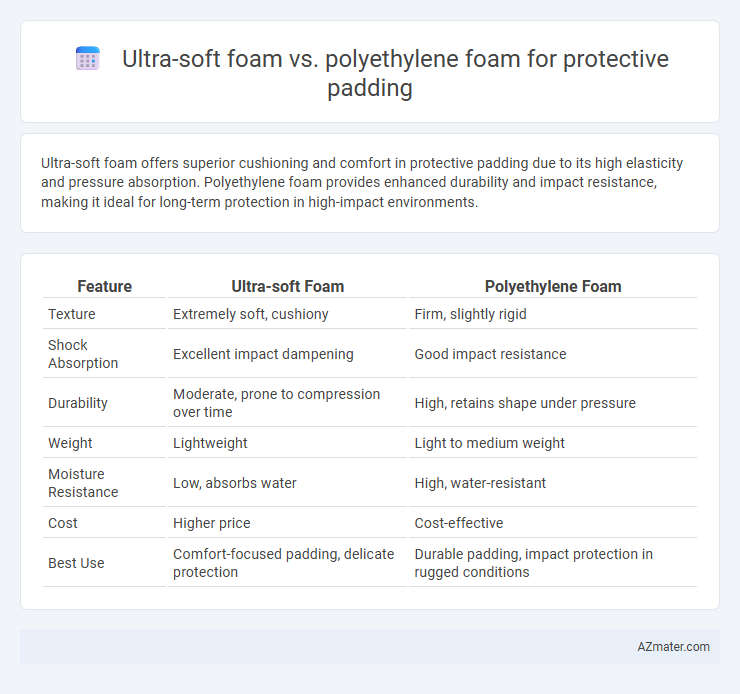Ultra-soft foam offers superior cushioning and comfort in protective padding due to its high elasticity and pressure absorption. Polyethylene foam provides enhanced durability and impact resistance, making it ideal for long-term protection in high-impact environments.
Table of Comparison
| Feature | Ultra-soft Foam | Polyethylene Foam |
|---|---|---|
| Texture | Extremely soft, cushiony | Firm, slightly rigid |
| Shock Absorption | Excellent impact dampening | Good impact resistance |
| Durability | Moderate, prone to compression over time | High, retains shape under pressure |
| Weight | Lightweight | Light to medium weight |
| Moisture Resistance | Low, absorbs water | High, water-resistant |
| Cost | Higher price | Cost-effective |
| Best Use | Comfort-focused padding, delicate protection | Durable padding, impact protection in rugged conditions |
Introduction to Protective Padding Materials
Ultra-soft foam and polyethylene foam are widely used materials for protective padding due to their distinct cushioning properties and impact absorption capabilities. Ultra-soft foam offers superior comfort and flexibility, making it ideal for applications requiring gentle pressure distribution and enhanced wearer comfort. Polyethylene foam excels in durability and resistance to moisture and chemicals, providing robust protection in industrial and sports settings where high-impact resistance is essential.
What is Ultra-Soft Foam?
Ultra-soft foam is a lightweight, highly compressible material known for its superior cushioning and shock-absorbing properties, making it ideal for protective padding in sensitive applications. Unlike polyethylene foam, ultra-soft foam offers enhanced comfort and flexibility, conforming closely to the shape of the protected object or body part. It excels in environments requiring gentle impact absorption with minimal pressure points, such as medical padding and delicate equipment protection.
Overview of Polyethylene Foam
Polyethylene foam is a lightweight, closed-cell material known for its excellent impact absorption and moisture resistance, making it ideal for protective padding applications. Its durability and high tensile strength allow it to withstand repeated compression without permanent deformation, ensuring long-term protection. Compared to ultra-soft foam, polyethylene foam offers superior structural support and environmental resilience, enhancing safety in packaging and sports equipment.
Key Properties: Ultra-Soft Foam vs Polyethylene Foam
Ultra-soft foam offers superior cushioning with exceptional compressibility and energy absorption, making it ideal for sensitive, impact-prone areas. Polyethylene foam boasts high durability, excellent moisture resistance, and greater structural rigidity, providing consistent protection in harsher environments. Selecting between these foams depends on balancing comfort needs with durability and environmental exposure.
Cushioning and Impact Absorption Comparison
Ultra-soft foam offers superior cushioning by conforming closely to body contours, ensuring enhanced comfort and pressure distribution. Polyethylene foam provides excellent impact absorption due to its higher density and closed-cell structure, effectively dispersing shock forces during high-impact activities. When selecting protective padding, ultra-soft foam excels in comfort-driven applications, whereas polyethylene foam is optimal for scenarios requiring robust impact resistance.
Durability and Longevity
Ultra-soft foam offers superior cushioning but tends to degrade faster due to lower density and resilience compared to polyethylene foam, which provides enhanced durability and retains shape under repeated impact. Polyethylene foam's closed-cell structure resists moisture, chemicals, and compression set, extending the protective padding's longevity in demanding environments. For applications requiring long-term use and consistent performance, polyethylene foam delivers a more reliable and durable solution than ultra-soft foam.
Comfort and User Experience
Ultra-soft foam offers superior cushioning and conforms better to body contours, enhancing comfort during prolonged use in protective padding. Polyethylene foam provides excellent impact absorption and durability but tends to be firmer, potentially reducing user comfort. Choosing ultra-soft foam improves overall user experience by minimizing pressure points and increasing flexibility, ideal for applications demanding extended wear and comfort.
Applications in Protective Padding
Ultra-soft foam excels in cushioning impact-sensitive equipment and delicate body parts due to its superior shock absorption and conformability, making it ideal for protective padding in medical braces and sports gear. Polyethylene foam offers lightweight, rigid support with excellent energy dispersion, commonly applied in helmets, protective cases, and industrial padding where durability and resistance to compression are critical. Both foams provide tailored protective solutions, with ultra-soft foam favored for comfort and sensitivity, while polyethylene foam is preferred for robust protection and structural stability.
Cost and Availability
Ultra-soft foam generally costs more than polyethylene foam due to its specialized material properties and comfort level, which can impact budget considerations for large-scale protective padding projects. Polyethylene foam is widely available and produced at a lower cost, making it a more economical choice for applications requiring bulk quantities and widespread distribution. Availability of ultra-soft foam may be limited to niche suppliers, while polyethylene foam benefits from large-scale manufacturing and extensive market presence.
Choosing the Right Foam for Your Needs
Ultra-soft foam provides superior cushioning and comfort, making it ideal for applications requiring gentle impact absorption, such as medical or delicate equipment padding. Polyethylene foam offers higher durability and resistance to moisture and chemicals, suitable for heavy-duty protection and outdoor environments. Selecting the right foam depends on factors like impact sensitivity, environmental exposure, and longevity requirements, ensuring optimal protection tailored to specific needs.

Infographic: Ultra-soft foam vs Polyethylene foam for Protective padding
 azmater.com
azmater.com